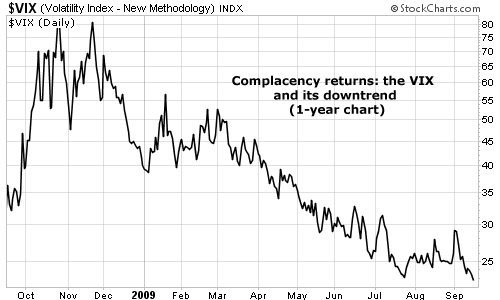| Home | About Us | Resources | Archive | Free Reports | Market Window |
A 73% One-Year Return on Your CashBy
Friday, September 18, 2009
If I hadn't done this a few times already, I wouldn't think it's possible...
But it is possible. We've done it. Exactly one year ago, I told my True Wealth subscribers to buy shares of Hatteras Financial (HTS). As I write, the total return on that recommendation (including dividends) is 73%. Over the same period, the stock market is down about 10%. Another big dividend is just around the corner for Hatteras, and that will push the total return into the 80% range. That is just incredible – particularly when you understand what business Hatteras is in. The business is simple: Hatteras borrows money at roughly 2% and invests it in government-guaranteed securities at roughly 5%. That's it! It earns the "spread" – about 3%. It uses about six times leverage (about half of what banks do). I call Hatteras a "virtual bank" because it does what a bank does – it earns a spread – but it has no storefront and no tellers. It simply takes investor cash and acts like a super-safe bank with it. The important differences are 1) Hatteras takes absolutely no credit risk – it only buys government-guaranteed securities, and 2) it uses much less leverage than banks. According to the most recent numbers, Hatteras earns a 21% return on equity. That's the highest return on something that's not much riskier than cash out there today. Thankfully for its shareholders, Hatteras pays out nearly all the money it earns as dividends. The official dividend yield on Hatteras today is 14% – but that could go up. My most recent advice to my paid subscribers was to hold Hatteras until we had a total return of 80%, or 18 months, whichever came first. I'm sure readers couldn't believe it when I told them we could make 80% on a business that takes cash and invests it in government-guaranteed securities. But we did! And there are more gains to come. The reality is, virtual banks are in their "sweet spot" right now, thanks to the government artificially cutting interest rates to such low levels. You want to own them when the interest-rate spread is wide, like it is now. Right now, it's artificially wide... so these guys can make a lot of money! Last year, we bought Hatteras because it was cheaper than our first choice – Annaly. Annaly has a much longer history than Hatteras, so I was more comfortable with it. Now, Annaly is trading at less than 1.2 times book value. Hatteras has treated us well. But it is now a bit expensive... It is currently trading at around 1.4 times book value – that's pretty pricey for a virtual bank. I expect both Annaly and Hatteras will trade up to 1.5 times book value in the next six months. Since Annaly is only at 1.2 times book value, your potential for capital gains is higher in Annaly right now than in Hatteras. So for new money, I prefer Annaly. You want to be OUT of virtual banks before the Fed starts hiking interest rates again – because the big profits are typically over by then. The odds are the Fed won't hike rates until the end of April 2010. So virtual banks are worth owning until, say, February 2010. That gives you about six months to earn a huge dividend on your cash – and make some healthy capital gains, too. Consider buying Annaly now, and selling it within six months or once it hits 1.5 times book value. Between dividends and capital gains, you could make 30% on a darn safe investment. Good investing, Steve
Further Reading:
The Best, Safe Investment of 2009 Pays 19% Interest Market NotesCOMPLACENCY RETURNS TO THE STOCK MARKET
Volatility, we hardly knew ye.
Back in 2006, we pointed to depressed levels of the VIX as an excuse to buy cheap "portfolio insurance" against the likes of terrorist attacks and government-sponsored disasters. The VIX measures the price investors are willing to pay for forms of portfolio insurance... so it's a great gauge of investor fear. Back then, only the paranoid thought about home foreclosures, job losses, or market crashes. Nobody cared much about insurance. Which – as any good contrarian can tell you – is precisely the time you should buy some. The VIX sat at an "asleep at the wheel" level of 12. Disaster hit in 2008... and sent the VIX to a "we're scared to death" level of 80. But as you can see from today's chart, complacency has returned to the market. The VIX has come down the mountain to reach 24. It's amazing proof that most investors have very short memories... 
|
In The Daily Crux
Recent Articles
|

